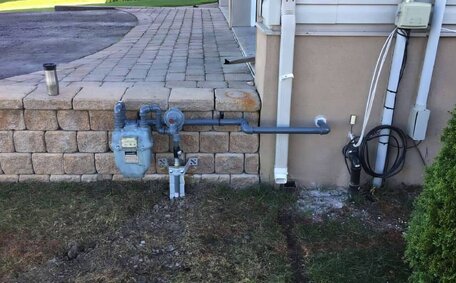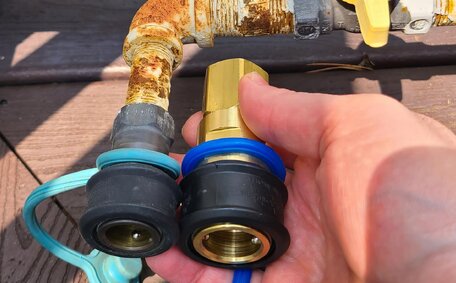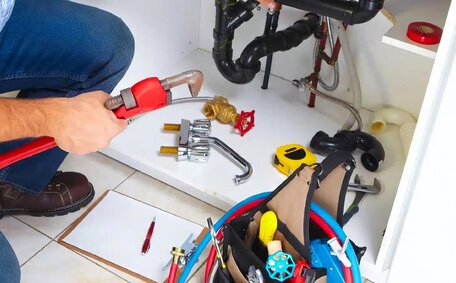Introduction to Pipe Relining
Pipe relining is a no-dig repair technique that mends pipes from within, eliminating the need for excavation. This entails carrying out the insertion of an environmentally friendly resin-impregnated liner into the existing conduit, which then cures to create pipe within the old one.
In heritage buildings, pipe relining provides a clean solution for modernising outdated drainage systems. As there is no need to dig trenches, it prevents damage or disruption to the surrounding structures and landscapes, and blocked drains can be unclogged with minimal disruption. Flexible liners can navigate intricate pipe routes, effortlessly handling bends and hard-to-reach areas.
With over 10 years of experience, Marsfield Plumbing’s proficient team skillfully undertakes pipe relining across various structures, giving meticulous attention to every pipe in need.
We comprehend the unique prerequisites of heritage sites, and our clients frequently decide to utilise our services, opting to use them again owing to our proven expertise in handling their specific needs, employing trenchless methods to safeguard original materials and architecture. This article discusses the advantages of pipe relining, examining both its challenges and benefits for such projects.
Challenges of Pipe Work in Heritage Buildings
Carrying out pipe work in heritage buildings poses multiple challenges. Accessing the pipes themselves can be extremely difficult due to narrow spaces, awkward angles, and the need to carefully navigate around existing architecture without causing damage.
There are also strict regulations in place regarding heritage approvals for any building modifications. Detailed plans often need to be submitted and approved before starting work. Such bureaucratic hurdles can induce delays and may call for costly interventions, especially with essential services like stormwater drains.
Pipe repairs require precautions to maintain the structural integrity of the building. Trenchless methods like pipe relining avoid this issue by
Another consideration is the pipe materials found in heritage buildings, requiring precise repairs. Cast iron drainage systems from the 1960s typically have a lifespan of around 50 years. If not replaced, damaged cast iron pipes may now necessitate significant overhauls or full replacements.
The insight of a skilled drain specialist is imperative when navigating the unique challenges and intricacies of sewer line projects within heritage listed properties. Advanced trenchless pipe relining technology effectively manages your plumbing issues with minimal disruption to your historical surroundings.
Limited Access
One of the biggest obstacles when considering relining vs pipe replacement in heritage buildings is extremely limited access to the sewer pipe network. Narrow passages, confined crawl spaces, challenging angles, and proximity to delicate structures can make direct pipe contact difficult or impractical.
Trenchless relining supplants traditional methods, sidestepping the need for clear access and excavation. This would necessitate breaking through walls and floors in a heritage building – potentially causing major damage or even completely destroying intricate historical features.
Pipe relining and relining pipe patching offer comprehensive solutions that work despite not having direct pipe access. We use cutting edge CCTV drain cameras to thoroughly inspect the pipes internally and identify the precise location and degree of the damaged drain. enabling the creation of a new pipe through a successful relining process. As the liner expands to seal cracks and holes, it hardens to form a smooth new wall inside your drain.
From the inside out, pipe relining facilitates high-quality repairs without damaging walls or creating trenches. Thus, pipe relining becomes the optimal non-intrusive choice to quickly fix problem areas during your heritage drainage system’s restoration.
Fragile Infrastructure
Heritage buildings often have old pipe and fragile infrastructure that requires careful handling during any repairs or upgrades. Original pipes and drainage systems can be extremely delicate, often requiring custom made solutions after decades of use.
Traditional open trench repair methods can cause significant pipe damage and disturbances, requiring heavy equipment. This invasive approach risks directly damaging fragile old pipes or structures. The tremors from digging up large amounts of earth can threaten structural stability, yet all our work is delicately handled to avoid such concerns.
Pipe relining circumvents these issues as it operates entirely within the existing pipes, repairing breaks from within. The resin liner is flexible, adapting snugly to the pipes without force.
Trenchless relining also conserves architectural details, seamlessly blending new infrastructure with the old. Original flooring, walls, gardens, and other sensitive heritage attributes stay intact as they don’t need to be altered.
When dealing with the one-of-a-kind infrastructure in heritage properties, non-invasive trenchless solutions like pipe relining are essential. The relining process, among other methods, can seamlessly refurbish pipes allowing effective restoration and upgrades without risking any architectural harm.
Preservation Requirements
There are strict legal requirements involved when working on heritage listed sites that must be carefully followed. Any building over 50 years old may require heritage approvals before starting plumbing repairs or upgrades.
Guidelines are in place to protect heritage architecture and ensure changes to sewer pipes are sympathetic to the original features and design intent. As your local experts, we are experienced dealing with council approvals processes and can provide a great job on meeting heritage regulations.
Pipe relining emerges as a primary solution that does require minimal intervention for your heritage compliance necessities. As no digging or damage occurs, it prevents disturbance to culturally significant landscapes. The liners’ ability to mimic original pipe paths ensures the conservation of heritage infrastructure.
Conservation standards endorse minimally invasive methods like relining that safeguard fragile structures, ensuring the safety of your home. Any heritage fabric like pipe materials are retained and strengthened.
When restoring the delicate infrastructure of heritage properties, pipe relining ticks all the boxes. It facilitates essential upgrades while fulfilling legal responsibilities to preserve these irreplaceable historic sites.
Benefits of Trenchless Pipe Relining
Trenchless pipe relining holds numerous advantages over traditional open trench methods for heritage sites, including:
Minimal Invasion
Excavating the ground for exploratory holes or trenches is unnecessary due to advanced CCTV pipe inspection cameras. This prevents disturbance or damage to surrounding structures and landscapes, including the preservation of aged pipes.
Structural Integrity
With no digging necessary, vibrations and earth movement are avoided, which can also safeguard sensitive heritage infrastructure.
Cost and Time Savings
Eliminating the need for surface restoration from trenching leads to projects that are ideal for your timeline and budget, enabling us to see the job through from start to finish in merely a few hours, offering significant cost savings.
Case Studies of Successful Projects
Our method has been successfully implemented to resolve drainage issues and enhance systems throughout numerous heritage sites, all the while preserving delicate architecture. Some real-world examples include:
Commonwealth Bank Building, Sydney
When sections of the 1920s plumbing infrastructure failed in this iconic heritage bank building, the non-intrusive nature of pipe relining made it a compelling repair option. The state-of-the-art technology in our nuflow system’s trenchless relining approach restored the ageing pipes from the inside out, steering clear of any damage or disruption your property’s ornate tiled floors and walls could suffer.
The Horizon Apartments, North Sydney
This luxury 1930s residential high-rise required essential sewerage upgrades. To map the intricate vertical sewer network, we employed the latest CCTV cameras, navigating through the labyrinth of inaccessible pipes within the building’s walls. Liner, custom-designed for the pipes, were then put in place, assuring structural rehabilitation without impacting the historical essence.
These case studies demonstrate that with the right expertise and technology, essential pipe refurbishments can be sensitively achieved in heritage contexts. The adaptability and non-invasive nature of the pipe relining solution make it ideal for sites where careful preservation is paramount.
Conclusion
When focused on maintaining and upgrading delicate infrastructure in heritage structures, the relining pipe technique proves to be an excellent choice. By introducing epoxy resin into existing conduits, your plumbing system can be restored smoothly without excavating or inflicting damage to the neighbouring heritage treasures.
As demonstrated through real-world case studies, drain pipe relining enables non-disruptive structural remediation and prolonged lifespan of ageing sewer lines.
For any heritage sites requiring drain pipes repairs, Marsfield Plumbing, a leading relining company, possesses advanced trenchless technology and expertise, executing repairs with meticulous attention. With over ten years servicing the Marsfield community, our expert understanding of heritage requirements sets us apart in plumbing reparations. We welcome you to contact us for a discussion about the tailored trenchless drain repairs your heritage property needs, including assistance with heritage approvals.






